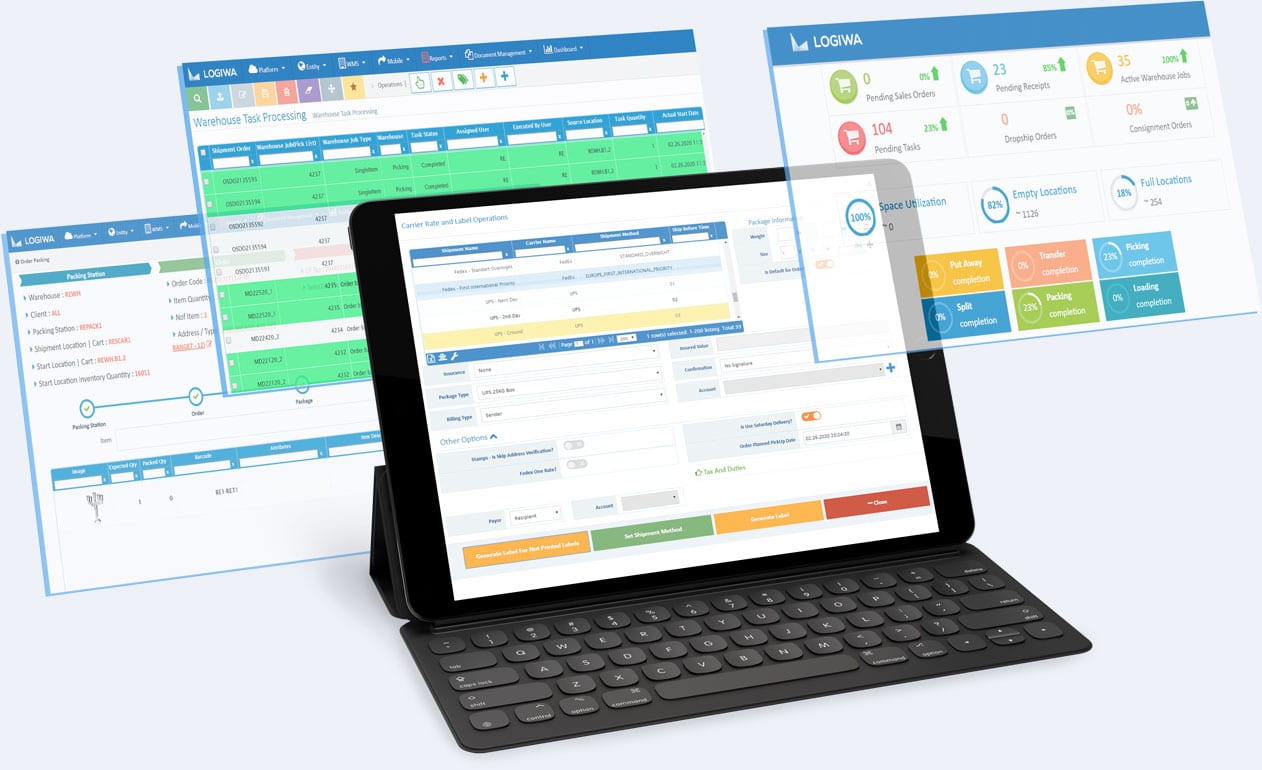In the frenzied rush of peak season, staying ahead is not just a goal—it’s a necessity. Warehouse KPIs hold the key to success. With the right insights, you can streamline operations, prevent setbacks, and enhance fulfillment results during the busiest shopping seasons.
Measuring warehouse performance and fulfillment metrics gives you a way to navigate the uncertainties of peak season. Here are the strategies and metrics to track to overcome peak season challenges and safeguard fulfillment excellence.
Key Takeaways
- Warehouse KPIs provide real-time insights, enhance efficiency, and help prevent setbacks during peak season.
- KPIs enable fulfillment operations to steer in the right direction, make agile decisions, and ensure customer satisfaction.
- Tracking uptime, daily shipments, lead time, errors, returns, costs, labor productivity, delayed shipments, and inventory turnover improve peak season performance.
- By combining multiple KPIs, warehouses can identify bottlenecks, streamline processes, and improve labor management.
- Logiwa Analytics empowers warehouses to achieve peak performance and fulfill brilliantly year-round.
Contents
Leveraging Warehouse KPIs for a Better Peak Season
Preparation is crucial for peak season months. Once peak season arrives, it is important to conduct your high-volume operations using key performance indicators (KPIs).
Gain invaluable insights into your operations.
Measuring warehouse performance and fulfillment results provides real-time snapshots and clarity into your operations. It helps you gauge the health of your operations, identify trends, and make informed decisions.
Enhance warehouse efficiency and fulfillment results.
Actively tracking KPIs improves results. By analyzing the right metrics, you can pinpoint weaknesses and bottlenecks in your processes. You can implement strategic adjustments, optimize workflows, and enhance overall performance.
This proactive approach boosts productivity and ensures resources are better used, leading to higher customer satisfaction and increased revenue.
Take preventative action to protect your business.
Monitoring KPIs serves as a powerful preventative measure. By identifying emerging problems, you can take corrective actions before they escalate into major issues. For instance, spotting a decline in daily shipments can prompt intervention, prevent backlogs and safeguard customer experience. Similarly, monitoring lead time can help anticipate supply chain disruptions, allowing for timely adjustments to maintain seamless operations.
KPIs enable you to steer operations in the right direction, make agile decisions, and ensure customer satisfaction. For insights how leading fulfillment operations are thriving during peak season, download, “Driving Impactful Peak Season Results.”

Transform your warehouse to a DTC fulfillment center
9 Warehouse Metrics for Improving Peak Season Performance
By actively harnessing specific performance metrics, you can come out on top of peak season. Consider these KPIs as you tackle peak season order volumes.
Uptime
During peak season, every second of order processing counts. When demand is at its peak, even brief system outages can result in major losses. This includes missed sales opportunities, fulfillment delays, and damage to your brand reputation. Promote steady, reliable order processing and avoid disruptions by monitoring uptime.
Daily Shipments
In the era of fast, easy deliveries, same-day shipping matters a great deal. Tracking same-day shipments helps you gauge the health of your operations. During peak season, it keeps you agile and on top of competitive fulfillment standards. This strengthens your position in today’s ecommerce market and helps you compete with companies like Amazon.
Lead Time
Lead time shows how agile your order processing is. The shorter your lead time, the smoother your operations are flowing. Track lead time to maintain the health of your operations, prevent backlogs and allocate resources properly. This will help you achieve speedy deliveries and higher rates of customer satisfaction.
Tracking Errors
Monitoring error rates (e.g. missing or damaged items) within your WMS can tell you a lot about the state of your warehouse operations and supply chain. High error rates can lead to unhappy customers, increased costs, and complex inventory problems. Track these metrics to identify areas for improvement during demanding periods.
Returns
Monitoring returns offers valuable insights into the success of your operations. It can help you identify issues stemming from a variety of sources. That includes ecommerce channels, fulfillment operations, vendor quality and shipping carriers. By tracking and analyzing return rates, you can take corrective actions that enhance customer satisfaction and keep profits high.
One return can cancel out the profits of 8-10 good sales. Track fulfillment accurate rates or “perfect order rates,” order picking accuracy, and inventory accuracy to directly combat returns.
Costs
Peak season is about maximizing profits. Tracking your costs empowers you to make adjustments to your operation and stay within budget. It also ensures you do not pass on unnecessary expenses to your clients and customers. For example, if your shipping costs are becoming higher than expected, you can switch to another carrier.
Labor Productivity
Tracking labor productivity directly impacts labor planning during peak season. This includes tracking the number of orders processed by employees each day, as well as how long it takes. With this information, you can assess your capacity to meet increased demand. You can also identify bottlenecks, improve workflow, and ensure faster order fulfillment.
Delayed Shipments
Delayed shipments lead to increased costs, unhappy customers, and a messy warehouse. By tracking delayed shipments, you can then identify the cause and take decisive action to prevent future delays. For example, you may need to:
- reorder certain items sooner
- set new thresholds for replenishment
- automate more warehouse processes
- hire additional staff
- switch to more dependable shipping carriers
Inventory Turnover
Tracking inventory turnover rates allows you to avoid overstock or stockouts. It helps you forecast demand and meet customer expectations as order volumes and consumer trends fluctuate. Using this KPI will ensure you are able to increase cost savings, optimize storage space, and fulfill more orders.
Check out “8 Benefits of Using Warehouse Data & Analytics in DTC Fulfillment” for more insights on overcoming peak season.
Comparing Warehouse Efficiency Metrics
Combining multiple KPIs helps you make smarter decisions to improve peak season results.
For instance, comparing you average number of order picks and shipments each day can help improve your labor management
If daily order picks exceed your daily shipments, a bottleneck may be causing packing delays. Or perhaps you have inadequate staffing to oversee shipping tasks. However, if daily shipments are exceeding the number of picked orders, you may need more pickers. If shifting your staff is not enough, you may need to streamline your picking and packing strategies or adopt more automation.
Experience Your Best Peak Season Yet with Warehouse KPIs
Knowledge is power during peak season. Harnessing the right warehouse KPIs yields vital insights that ensure you act in the best interest of your business. It helps you steer your operations and enhance fulfillment results with ease.
KPIs help you snuff out problems before they can escalate into headaches. By staying on top of your numbers, you can make agile decisions and ensure customer satisfaction. Rather than surviving peak season, set the stage for year-round success.
Logiwa Analytics
If you aren’t making data-driven decisions, you are limiting what your operation can achieve. Your ability to manage, interpret, and use data is a key factor in fulfilling brilliantly. Learn more by watching our on-demand webinar, “Winning DTC Fulfillment with Analytics.”
Logiwa Analytics analyzes your warehouse management data, so you don’t have to. As part of Logiwa’s complete fulfillment solution, it unites all your key data. For more insights on our fulfillment management system, request a demo.
FAQs Related to Warehouse KPIs
What are key performance indicators in warehousing?
Key performance indicators (KPIs) in warehousing are specific metrics used to measure and evaluate the efficiency, productivity, and overall performance of warehouse operations. These metrics help assess critical aspects like order accuracy, on-time deliveries, inventory management, labor productivity, and cost-effectiveness. By tracking KPIs, warehouses can make data-driven decisions to improve their processes and ensure optimal performance.
How often should I report on warehouse KPIs during peak season?
Regular reporting is key. The choice of reporting frequency depends on the specific KPIs, the nature of your business, and the need for real-time insights. During peak season, daily or weekly reporting will benefit your operation most. Frequent reporting ensures you are well-informed and can take timely actions.
What warehouse efficiency metrics should I track during peak season?
Focus on key performance indicators (KPIs) like order accuracy, on-time delivery rates, picking and packing efficiency, inventory turnover, and labor productivity. These metrics help ensure efficient operations, minimize errors, and meet the high demand while maintaining customer satisfaction. Tracking these KPIs allows fulfillment centers to adapt quickly and thrive during the busiest times.
Go Beyond Traditional WMS with AI-Powered Fulfillment Solution.
Warehouse Management
Modern digital WMS powers a modern fulfillment experience





